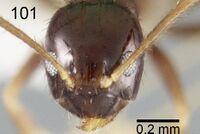Nylanderia xestonota
| Nylanderia xestonota | |
|---|---|

| |
| Scientific classification | |
| Kingdom: | Animalia |
| Phylum: | Arthropoda |
| Class: | Insecta |
| Order: | Hymenoptera |
| Family: | Formicidae |
| Subfamily: | Formicinae |
| Tribe: | Lasiini |
| Genus: | Nylanderia |
| Species: | N. xestonota |
| Binomial name | |
| Nylanderia xestonota LaPolla & Kallal, 2019 | |
Nothing is known about the biology of Nylanderia xestonota.
Identification
LaPolla and Kallal (2019) - Dark brown and distinctly shiny; gaster without pubescence; mesocoxae and metacoxae and petiole not distinctly lighter in color than mesosoma and gaster.
Compare with: Nylanderia fuscaspecula, Nylanderia sierra, Nylanderia wardi.
With their dark brown and very shiny appearance, workers of this species should be fairly easy to separate from other Cuban Nylanderia. It is similar in size to N. sierra, but unlike N. sierra, its mesonotum and gaster have no pubescence. In several features, workers of N. xestonota are most morphologically similar to workers of N. fuscaspecula from Hispaniola. They can be separated on two main features of the worker. In N. fuscaspecula the mesocoxae, metacoxae and petiole are all lighter brown in color and therefore contrasting distinctly with the remainder of the mesosoma. Whereas in N. xestonota those structures are dark in color and similar to the overall color of the mesosoma. Additionally, N. xestonota scapes typically have more macrosetae on them (range in N. xestonota 22–30, with an average of 27 macrosetae; the average macrosetae count in N. fuscaspecula is 23 with a range of 18–24).
Keys including this Species
Distribution
Latitudinal Distribution Pattern
Latitudinal Range: 20.015° to 20.003°.
| North Temperate |
North Subtropical |
Tropical | South Subtropical |
South Temperate |
- Source: AntMaps
Distribution based on Regional Taxon Lists
Neotropical Region: Cuba (type locality).
Distribution based on AntMaps
Distribution based on AntWeb specimens
Check data from AntWeb
Countries Occupied
| Number of countries occupied by this species based on AntWiki Regional Taxon Lists. In general, fewer countries occupied indicates a narrower range, while more countries indicates a more widespread species. |

|
Estimated Abundance
| Relative abundance based on number of AntMaps records per species (this species within the purple bar). Fewer records (to the left) indicates a less abundant/encountered species while more records (to the right) indicates more abundant/encountered species. |

|
Biology
Castes
Nomenclature
The following information is derived from Barry Bolton's Online Catalogue of the Ants of the World.
- xestonota. Nylanderia xestonota LaPolla & Kallal, 2019: 442, figs. 100-102 (w.) CUBA.
Unless otherwise noted the text for the remainder of this section is reported from the publication that includes the original description.
Description
Worker
(n=5): TL: 1.63–2.20; HW: 0.42–0.56; HL: 0.53–0.67; EL: 0.12–0.16; SL: 0.62– 0.78; WL: 0.63–0.76; GL: 0.57–0.92. SMC: 22–30 PMC: 3–4; MMC: 2. indices: CI: 81–90; REL: 22–24; SI: 134–145; SI2: 18–20.
Head: sides of head in full face view nearly parallel; posterolateral corners rounded; posterior margin rounded; anterior clypeal margin nearly straight; ocelli absent; eye well-developed. Mesosoma: in lateral view, pronotum convex; anterior margin of mesonotum raised slightly above posterior pronotal margin; metanotal area without a short flat area before spiracle; dorsal face of propodeum slightly convex; dorsal face of propodeum and mesonotum approximately the same height in lateral view. Color and pilosity: dark brown, with scapes, funiculi and legs becoming lighter especially distally; mandibles lighter yellowish-brown; generally, very shiny and without pubescence, except on head especially around eyes and fringe of pubescence on dorsal face of propodeum.
Type Material
Holotype worker, CUBA: Granma: Parque Nacional Pico Turquino, 20.00800, 076.86500, +/- 150 m, 1200 m, 3 Feb 2012, R.S. Anderson #RSA2012-024 (CASENT0630182) (National Museum of Natural History); 2 paratype workers, CUBA: Granma: Parque Nacional Pico Turquino, Cerro Joachin Peak, 20.01300, -76.83400 +/- 150 m, 3 Feb 2012, R.S. Anderson #RSA2012-022; 1 paratype worker, CUBA: Granma: Parque Nacional Pico Turquino, Aguada de Joachim, 20.01500, -76.84000 +/- 15 m, 1370 m, 3 Feb 2012, R.S. Anderson #RSA2012-023 (NMNH & Museum of Comparative Zoology).
Etymology
The species epithet is a combination of xesto (Gr. = polished) and nota (Gr. = back), in reference to the very shiny and smooth appearance of the mesosoma.
References
References based on Global Ant Biodiversity Informatics
- LaPolla J. S., and R. J. Kallal. 2019. Nylanderia of the World Part III: Nylanderia in the West Indies. Zootaxa 4658: 401-451.

